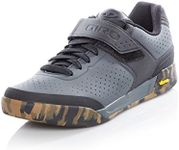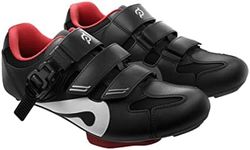Buying Guide for the Best Wide Bike Shoes
Choosing the right wide bike shoes is essential for comfort, performance, and foot health, especially if you have wider feet. The right pair will prevent discomfort, numbness, and hot spots during rides. When shopping, focus on how the shoes fit your feet, the type of riding you do, and the features that will make your cycling experience enjoyable and efficient. Understanding the key specifications will help you narrow down your options and find the best fit for your needs.Width SizingWidth sizing refers to how much space the shoe provides across the ball of your foot. This is crucial for riders with wider feet, as standard shoes can cause pinching and discomfort. Wide bike shoes are typically labeled as 'wide' or 'extra wide.' Some brands use letters (like E or EE) or simply offer a 'wide' version of their standard models. When choosing, try on different widths if possible, and make sure your foot feels supported but not squeezed. If your feet often feel cramped in regular shoes, opt for a wide or extra wide size to ensure comfort on long rides.
Closure SystemThe closure system is how the shoe fastens and secures your foot. Common types include Velcro straps, ratchet buckles, dials, and laces. Each system offers a different balance of adjustability, convenience, and security. Velcro is quick and easy, dials allow for fine-tuned adjustments, and laces can offer a more customized fit. For wide feet, look for closure systems that allow you to adjust the fit across the widest part of your foot, ensuring even pressure and no tight spots. If you have high-volume feet or need to make frequent adjustments, dials or multiple straps can be especially helpful.
Sole StiffnessSole stiffness determines how much the shoe flexes when you pedal. Stiffer soles transfer more power to the pedals, which is ideal for road cycling and racing, while more flexible soles are comfortable for casual riding or walking. Wide bike shoes come in a range of stiffness levels, often indicated by the material (carbon is stiffer, nylon is more flexible). If you prioritize performance and efficiency, choose a stiffer sole. If comfort and walkability are more important, a more flexible sole may be better. Consider your riding style and how much time you spend off the bike when making your choice.
Ventilation and MaterialsVentilation and materials affect how breathable and comfortable the shoes are, especially during long rides or in hot weather. Look for shoes with mesh panels or perforations if you ride in warm conditions, as these features help keep your feet cool. The materials also impact durability and weight; synthetic materials are often lighter and dry faster, while leather can offer a more natural fit over time. If you ride in various weather conditions, consider shoes with water-resistant features or those that dry quickly.
Cleat CompatibilityCleat compatibility refers to the type of pedal system the shoe works with, such as 2-bolt (mountain bike style) or 3-bolt (road bike style) patterns. It's important to match your shoes to your pedals for proper function and safety. If you use road bikes, you'll likely need 3-bolt compatibility; for mountain or casual riding, 2-bolt is common. Make sure the wide bike shoes you choose are compatible with your current pedals, or be prepared to switch pedal systems if needed.
Heel and Arch SupportHeel and arch support are important for overall comfort and to prevent foot fatigue or pain during rides. Wide bike shoes should provide a secure heel cup and adequate arch support to keep your foot stable. Some shoes offer removable insoles, allowing you to use custom orthotics if needed. If you have high arches or specific support needs, look for shoes with adjustable or replaceable insoles. Proper support will help you ride longer and more comfortably.



















